Dell XPS 13 Review
by Brett Howse on February 19, 2015 9:00 AM EST- Posted in
- Laptops
- Dell
- Ultrabook
- Broadwell-U
- XPS 13
Display
Dell offers two display choices in the XPS 13. The base model comes with an IPS 1920x1080 (Full HD, or FHD) Sharp 1420 panel, with LED backlighting of course. The upgrade is to the Sharp 1421 panel, which increases the resolution to 3200x1800 (QHD+), for 272 pixels per inch. Even 1080p on a 13.3 inch panel is a nice resolution, but the high DPI display really shines, especially in the new Windows 8 environment. Desktop apps can still have some issues with High DPI, but it is becoming less of a problem over time.
Sharp is the maker of all IGZO displays, which we have seen before in a couple of other devices such as the Razer Blade. The big benefit to IGZO (Indium Gallium Zinc Oxide) panels is they allow more light through the display, reducing the power requirements for the backlight. This generally means that we get to keep the full RGB stripe, which should help with color accuracy.
Being able to see both sets of pixels just shows how many more pixels are packed into the High DPI panel. 1080p is around 2 million pixels and 3200x1800 is 5.76 million pixels. It is a big difference and gives a big increase to clarity, but it comes with the cost of increased power usage, despite the IGZO TFT.
Dell has the displays listed as IPS (In-Plane Switching) panels on their spec sheet, and they do not seem to have any of the off-angle color shift of a VA (Vertical Alignment) design. Whatever the display type, it certainly is not TN (Twisted Nematic) so even at extreme angles there is not the loss of contrast associated with those displays. Also, you can see the anti-glare coating on the FHD pixels, which is the distortion shown on the subpixels.
To test the panels, we turn to SpectralCal’s CalMAN 5 software suite, the X-Rite i1Display Pro Colorimeter for brightness and contrast measurements, and the X-Rite i1Pro Spectrophotometer to measure the color accuracy.
One more note about the Dell displays though is that they have an auto-brightness adjustment with no way to disable it. It seems to manifest itself the most, and the most severe, when there are large contrast changes on-screen. For this reason, our automated testing for the color accuracy would not work at all because of the abrupt changes on the screen as it flashed among the various colors. This would cause the screen to go bright and dim and caused some very erroneous readings.
I was able to get around it for the color testing by manually going to on-screen color patterns, however display calibration is impossible with this brightness adjustment so that was skipped. I have contacted Dell to inquire about this issue and will give an update if they get back to me.
Update: Dell has enabled Content-Adaptive Backlight Control, which we have seen in other devices like the Nokia Lumia 930. Dell has let me know they are looking into a way to have the end user disable this feature.
First up is the brightness, contrast, and black levels.
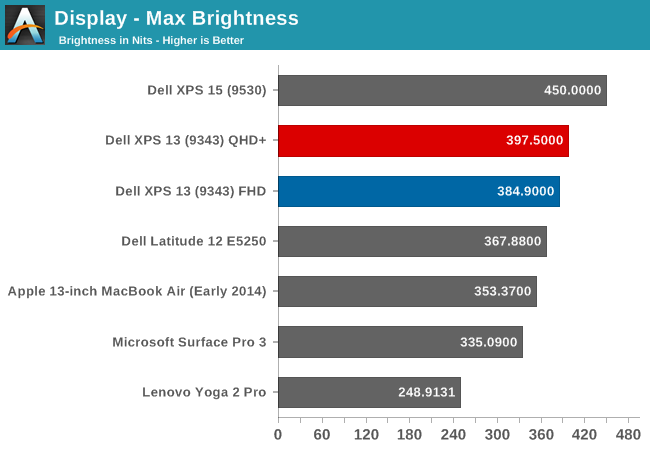
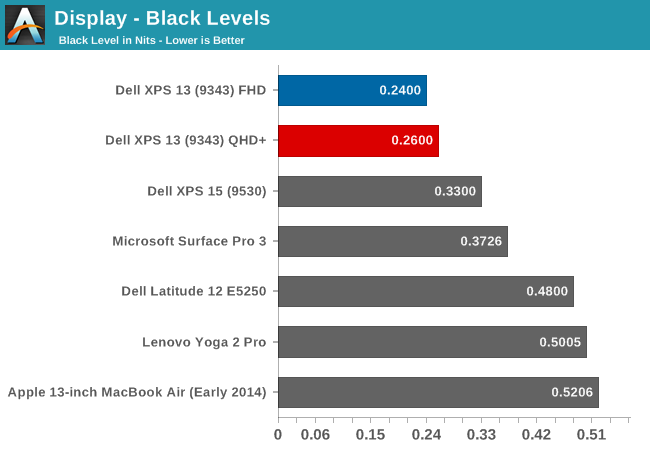
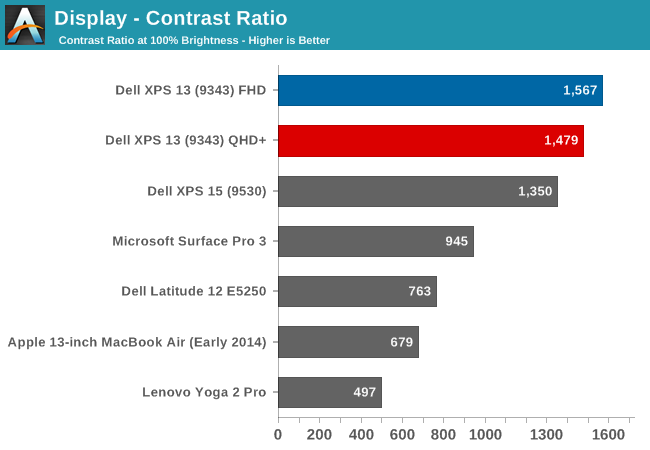
Both displays get very bright. Dell claims 400 nits brightness on the XPS 13 and we measured almost that much. Also, the black levels were very good on both displays, giving a contrast ratio close to 1500:1 on both units. Minimum brightness is around 16-17 nits on both models as well, so there is quite a bit of range on the displays to let them work on almost any situation.


On the QHD+ version, grayscale is a decent result, coming in around delta E of 3. The gamma unfortunately really drops off at the upper end of the range. The color temperature is a bit warm, and as the chart shows, the greens are a bit high. The FHD model does not fare so well, with the gamma going quite high, and the grayscale DE being almost 6.
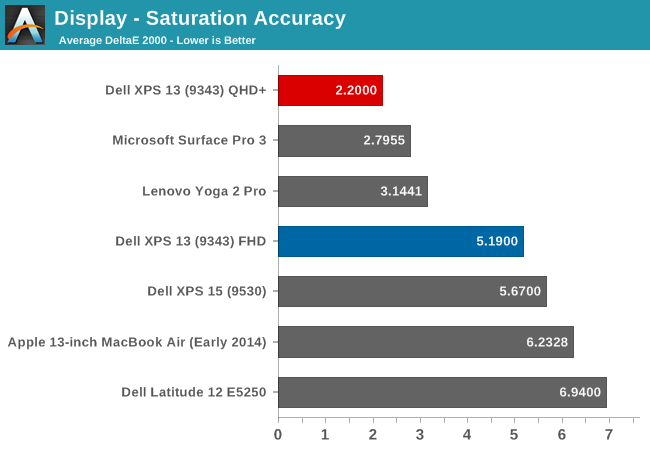
Dell does well on the saturations, with both displays being able to do the entire sRGB color space. Once again, the QHD+ model scores a lot better, with the saturation a very nice 2.2 dE, while the FHD version is closer to 5 - not an awful result, but much worse than the upgraded model.
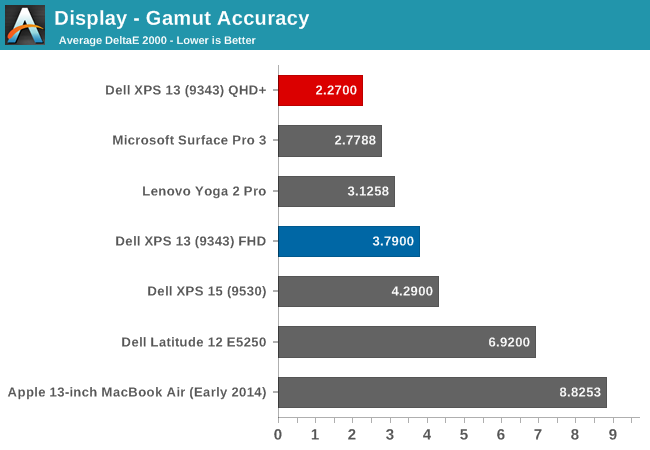
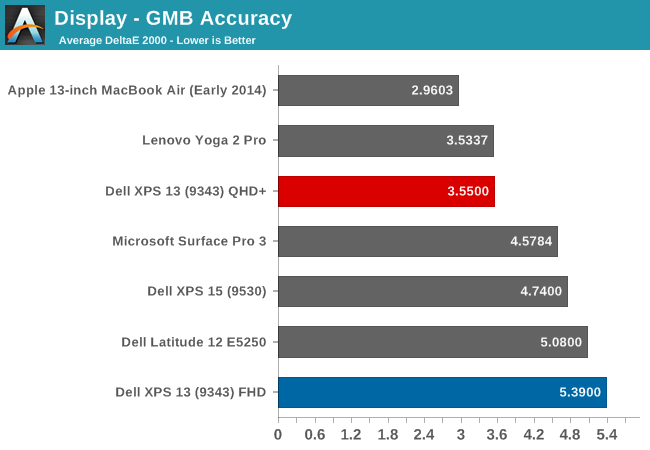
Wrapping up with the Gretag Macbeth results, again the QHD+ model does very well, with the FHD model just average. I have to note though, that even though the GMB score was very good on the QHD+ model, all of the colors that were off, with some of them around DE of 6, were the skin tones. Without calibration, anyone wanting to use this for photo editing may not much enjoy it, and with the auto-brightness issue, the calibration will not work so there is no way to see if the scores improve after calibration.
The Infinity Display is certainly one of the defining characteristics of the XPS 13, and especially with the QHD+ version the color accuracy and other characteristics are quite good. The Auto-Brightness is certainly an issue, and hopefully Dell will offer up a way to disable this either in software or the BIOS soon.


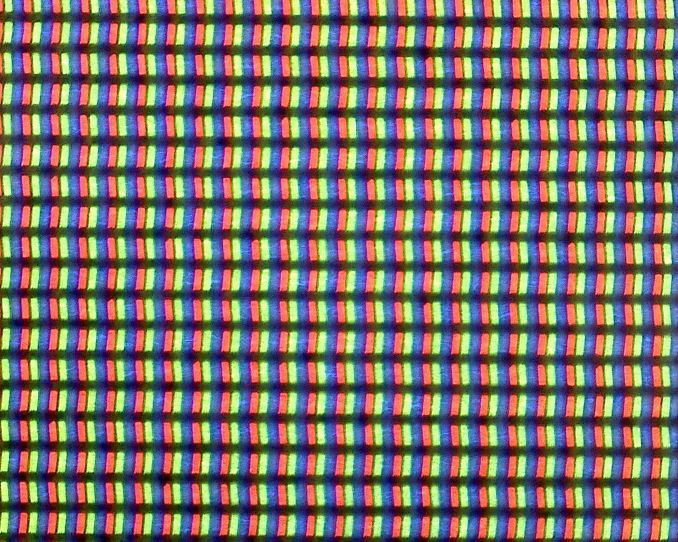
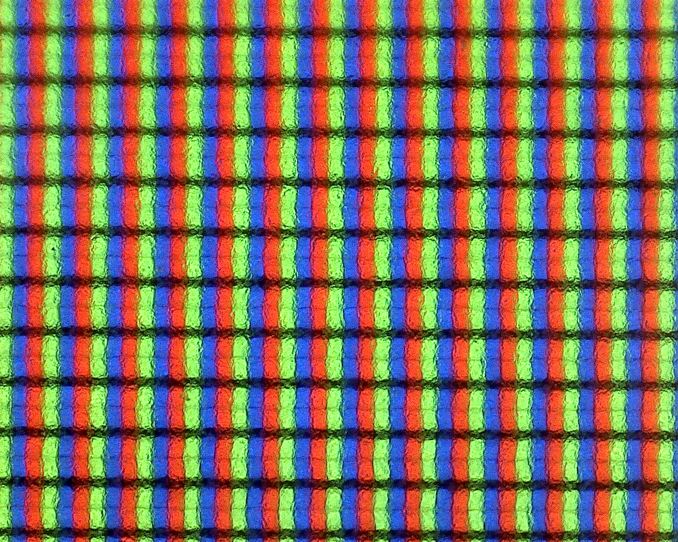
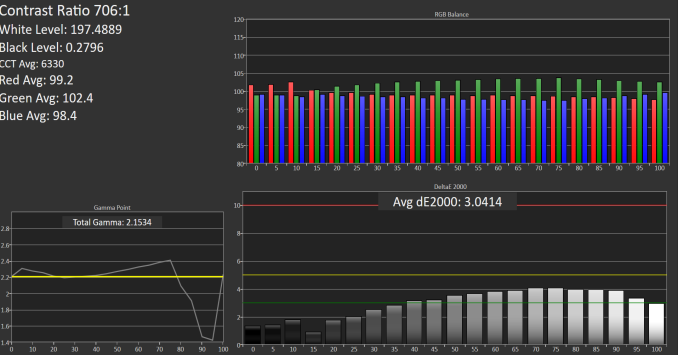
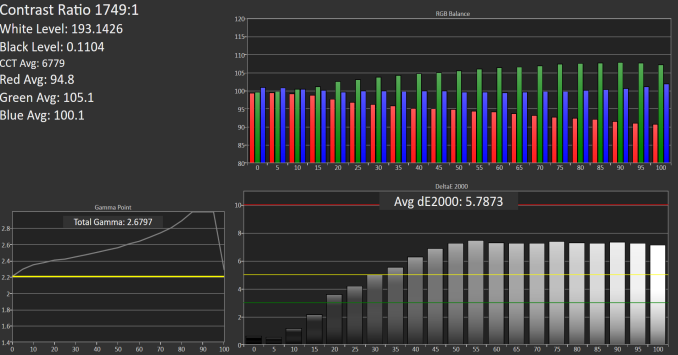
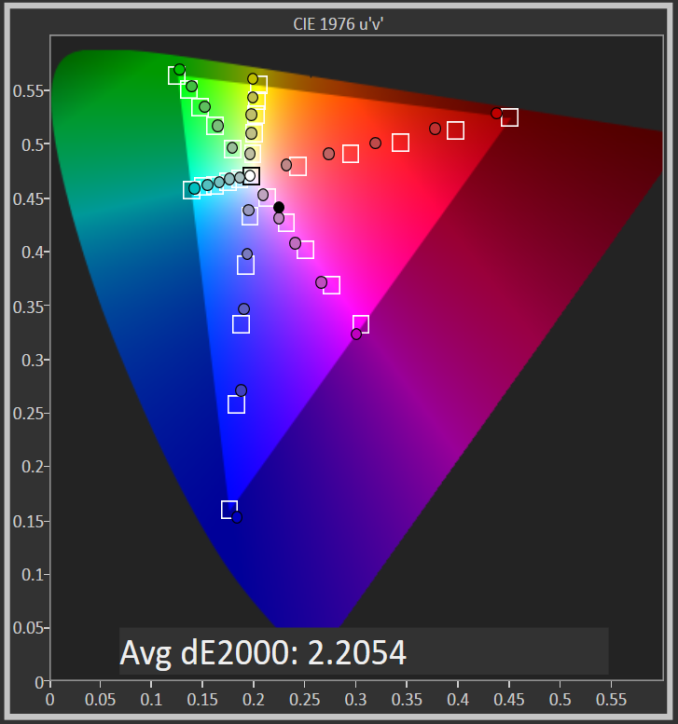

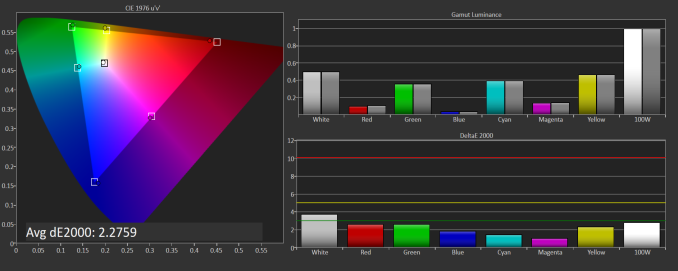
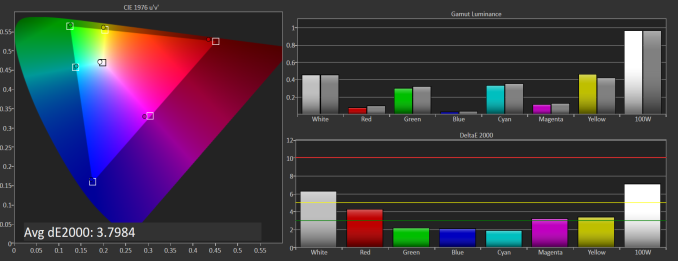

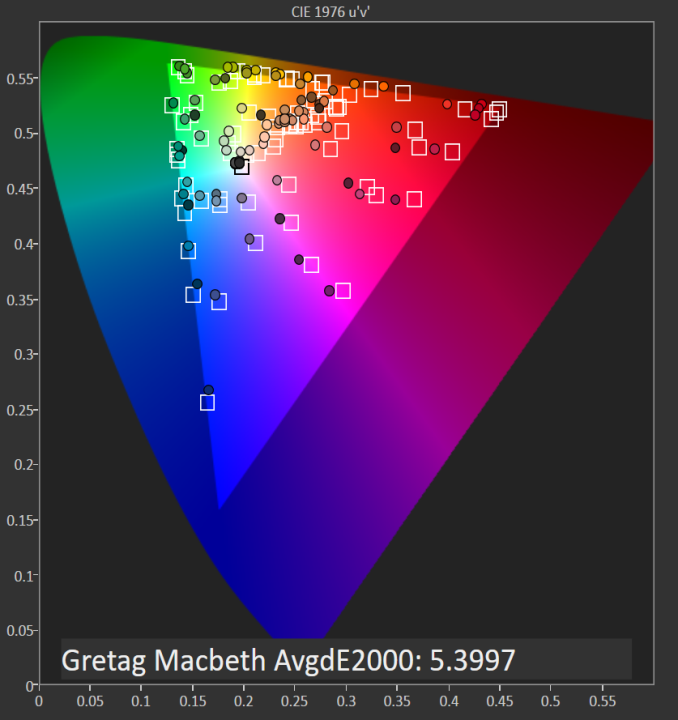








201 Comments
View All Comments
Brett Howse - Monday, March 23, 2015 - link
Someone else had asked me that, so I set the 3200x1800 display to 1600x900, just to see if part of the battery life loss was due to rendering. My battery life test for this setting was almost identical to the 3200x1800 resolution.So it does not improve battery life because the main power draw of the higher resolution display is the increased requirements of the backlight to drive the same brightness level through a much more dense TFT. At least that was my findings on the XPS 13.
growl - Monday, March 23, 2015 - link
Thanks very much, appreciate it! Torn on which one to buy, given that I am a frequent traveler, but also generally enjoy touch and have a pretty much unlimited budget.mazzy - Thursday, March 26, 2015 - link
Hi Brett, Any Update on Auto Dynamic LCD brightness ?Brett Howse - Saturday, March 28, 2015 - link
Nothing yet sorry.mazzy - Tuesday, April 7, 2015 - link
I think that it'll never be fixed. It's April.. over 3 months from the launch...It's a pity, a great quality screen but with a glaring defect... no calibration possible... :(
FranC - Wednesday, April 8, 2015 - link
I bought the 2015 Dell XPS 13 on the assumption that Dell would release a fix that would allow end users to calibrate the display. As mazzy said, it seems like Dell has no intention of fixing this, perhaps because it would reveal that battery life is highly dependent on Adaptive Brightness being enabled. Guess I'll wait to the last day to return it, and file this one away as being Duped-by-Dell.paul1508 - Monday, April 20, 2015 - link
Does the standard Dell Wireless 1560 support Intel Wireless Display (WiDi) or do I have to opt in the Intel AC 7260? Does that matter at all because the Dell Wireless 1560 might support Miracast?technoway - Monday, April 27, 2015 - link
The battery life for the system:i7-5500U / 8GB-RAM / 512GB-SSD / 3200x1800 infinity touch
is listed to be only about 7.5 hours.
The Apple 13-inch Macbook gets 10 hours or more.
But, Dell doesn't offer the 512 GB SSD, which I need for space, without also having the power-sucking HD+ screen. That stops me from buying the latest XPS-13.
Dell could make simple changes and make a machine I'd buy, but for some reason they don't do this.
The core i7 processor is a must, because it consumes less power than the core i5, and a 512 GB SSD is also a must to compete with Apple machines, but the HD+ screen wastes too much power. An HD screen is just fine on a 13-inch machine.
Until I can get a i7-5500U / 8GB-RAM / 512GB-SSD, with just the HD display (I don't care whether it's touch or not), I won't buy this. With the HD display, that system would have great battery life - I'd estimate at least 10 hours, and probably more like 11 or 12, maybe more. Dell ruins the machine by not offering the best options for battery life.
I do have an older first-generation XPS 13, and I like it, but with a meager 128 GB, 70 GB taken by the OS and restore partition, it's got too little storage.
If Dell makes the machine I want, I'll buy one tomorrow. If they don't make that by Christmas, I'll probably purchase the Apple 13 inch model. It has the good battery life for an Ultrabook.
Oh, and Dell's suggested solution for the poorer battery life is to carry around a plug-in battery pack for extra power. That competely defeats the purpose of having an Ultrabook!
vaga13ond - Saturday, June 11, 2016 - link
You're comparing apples to oranges there. Trying to compare the XPS vs a Macbook isn't really targeting the same user. Macbook's come with Core m3 or m5 (below i-series) processors not the i7 processor that you consider a "must." No touch screen, no QHD, worse on board graphics, DDR3, single port, yada yada yada... And no, the Macbook does NOT get 17.5+ hours on a battery charge doing anything besides idling. The XPS is a VERY different machine than the Apple Macbook...rgin - Monday, October 12, 2015 - link
Would the performance of this beauty be affected if we ran linux on it?